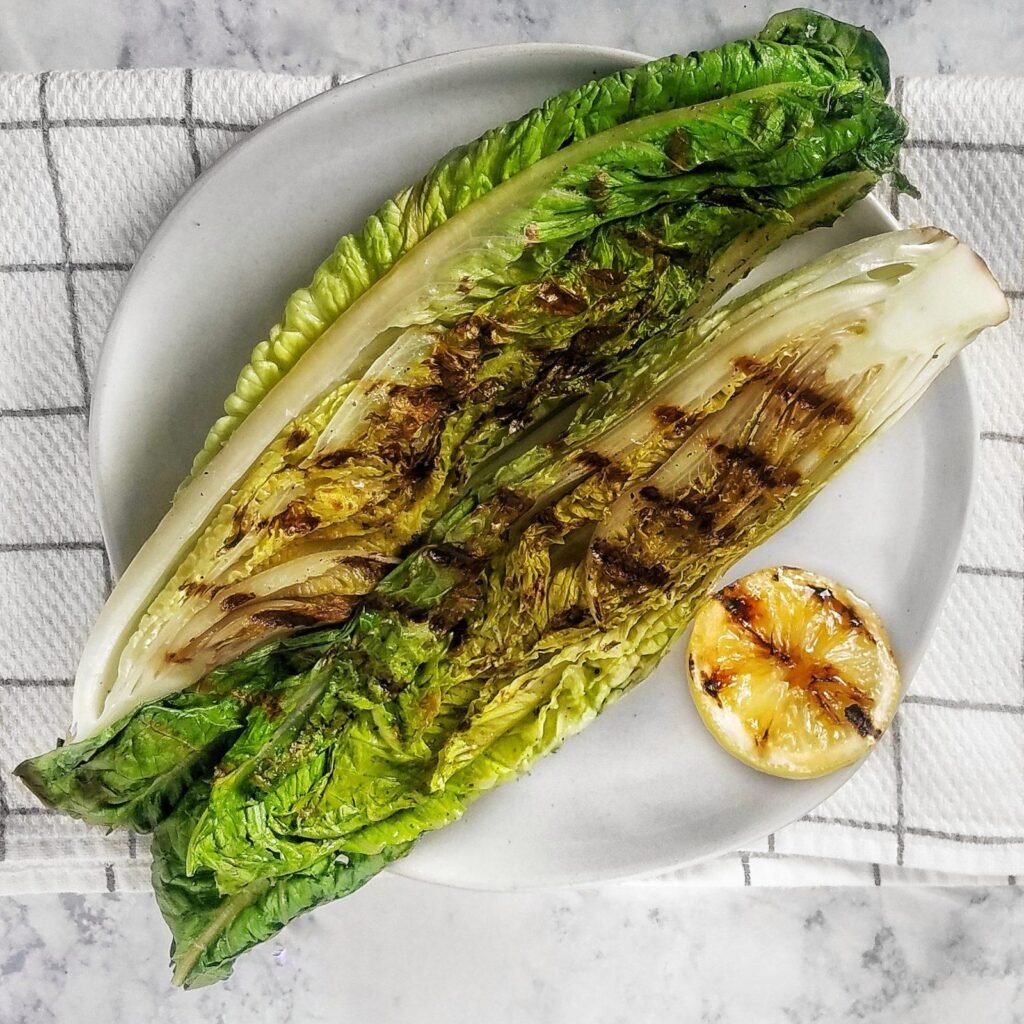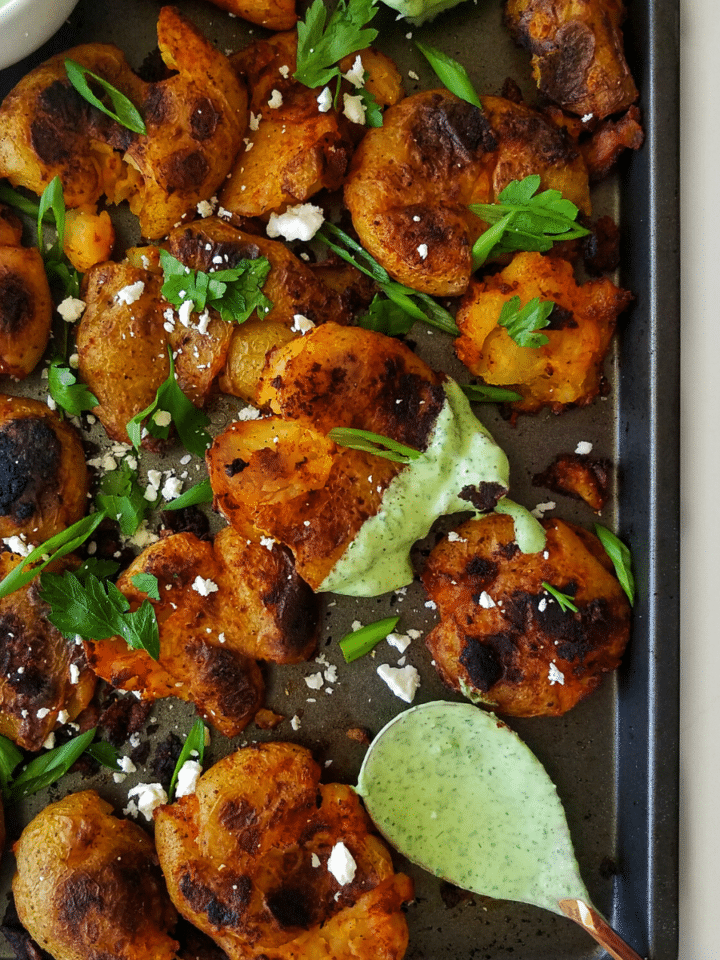My favorite summer recipe is a grilled salad made with canned trout, grilled potatoes, and asparagus, homemade croutons, and drizzled with a quick Caesar dressing.

This article contains affiliate links. Please see disclaimers page for more info.
intro
Last summer, I wrote an article about the importance of pantry cooking in hot weather. I wanted to share my favorite salad recipe that showcases a pantry staple of mine, Scout's Canned Trout with Dill.
Scout's Canned Seafood
Rainbow trout is one of my favorite fish. Its mild, delicate, nutty flavor pairs well with many dishes, so I was happy to find it in canned form. I discovered this craft seafood cannery on Instagram and immediately made an order.
Although my butcher does a great job of sourcing fresh seafood and even making custom orders when I need a whole fish, fresh seafood is hard to come by in the Midwest.
This company was intriguing to me because its products include more than just tuna. They also have canned lobster, trout, and mussels. Furthermore, they are sustainable, but they also emphasize minimal food waste, lower carbon footprint, and 100% recyclable packaging.
Par-boiling the potatoes
I like to par-boil my potatoes before grilling, so they don't take as long to cook. It is the perfect time to add extra flavor to your potatoes. I like to make salt and vinegar potatoes.
I use the same method in my Crispy Salt and Vinegar Smashed Potatoes. You can find that recipe here.
Here's how I make my potatoes.
I prefer using malt vinegar, but Apple Cider Vinegar is also good here. For the potatoes, I like a mix of baby yukon, red, and purple potatoes.
In a large dutch oven, add potatoes, malt vinegar, one (1) tablespoon of sea salt, and approximately three (3) cups of water. There should be just enough liquid to cover the potatoes.
This dutch oven from Staub is the perfect size!

Bring the potatoes up to a boil, then lower the heat to a gentle simmer. Let the potatoes continue cooking for 15 minutes, or until the potatoes can be pierced with a fork but still firm enough not to fall apart while slicing.
Since we will be grilling the potatoes, make sure the potatoes aren't too soft. Once the potatoes are fork-tender, allow them to cool in the liquid for a few minutes before removing them.
When the potatoes are cool to the touch, slice them in half. Set these potatoes on a baking sheet and toss with olive oil, salt, pepper, and smoked paprika.
Prepping the Asparagus
Next, prep the asparagus for grilling by trimming off the woody stems. Coat the asparagus spears in olive oil, salt, pepper, and chili flakes. Set aside until ready to grill.
Grilling veggies
To make grilling veggies much more manageable, use a specialty grilling pan with holes along the bottom, like this one, to get the smokey flavor without dropping food between the grates.
If you don't have a grill, use a cast iron grill plate, like this one. It gives you those charred grill marks right on the stove.
Check out these grill pans.
Heat the grill to medium-high. Place the potatoes and asparagus over direct heat. Then, cook until the veggies are tender and charring appears about 6 - 10 minutes. Once the asparagus cooks, cut it into bite-sized pieces after it's cooled.

Romaine lettuce
Grilling the romaine is optional but recommended. I use the same method in this salad recipe, too. Romaine lettuce is sturdy enough to hold up to grilling, and it gives it more flavor. However, if you choose not to grill the lettuce, chop it into thin strips.
How to grill romaine lettuce.
First, brush the romaine halves with olive oil and season with salt and pepper. Then, place the flat side down onto the hot grates. Quickly sear the lettuce until grill marks appear, then remove. Allow the romaine lettuce to cool slightly, then cut into strips.
Homemade sourdough croutons
My two favorite loaves of bread to use for homemade croutons are sourdough and focaccia. Although, I'll be honest. I cheat when I make sourdough bread at home. I use Red Star Brand Sourdough yeast starter, so I don't have to babysit a natural sourdough starter.
Regardless of what kind of bread you use, the methods are all the same, but depending on whether or not you have an outdoor grill pan, it will determine how you grill these croutons. Either way, these croutons can be grilled or roasted in the oven. It's your choice.
For grilling directly on the grates, slice the bread and grill the seasoned toasts until char marks form. After, cut them into bite-sized pieces. However, if you place the bread on an outdoor grill pan, you can tear the sourdough pieces into chunks.
But, again, I think the organic shapes look better in the salad.
If you use the oven, preheat the oven to 400 degrees F., then spread the sourdough pieces onto a baking sheet and bake until golden, about 10 minutes. You can turn the broiler on to give the croutons a charred effect.

Caesar-style Dressing
Creamy dressings are my all-time favorite, and making homemade Caesar dressing is straightforward. Caesar dressing gets its creaminess from the emulsion of raw egg yolks and oil.
However, consume raw eggs at your own risk as they may carry Salmonella bacteria. You can use two tablespoons of good-quality mayo for those who do not want to use raw eggs. I like Trader Joe's brand or Primal Kitchen mayo.
Additionally, I like my Caesar dressing to be pretty heavy on the anchovies. If you are using Scouts canned trout with dill, use the oil to make the Caesar dressing and adjust the amount of olive oil accordingly.
I strain the oil from the canned trout into a measuring cup, then fill in the rest of the way with good-quality olive oil like Brightland brand olive oil or local olive oil from my butcher.
To make homemade Caesar Dressing, add the anchovy, garlic, egg yolks, Parmesan, lemon juice and zest, and stone-ground mustard to a blender. I use a hand blender like this one. Next, puree until smooth, then while the blender is running, slowly pour in the olive oil in a thin stream until it is completely incorporated.
After, taste the dressing and add additional salt and pepper. If the Caesar dressing is too thick, mix in a tablespoon of water until you reach the desired consistency.

Assembling your Caesar Salad
I spend a lot of weekends browsing the farmer's market. My favorite one has the most delicious dinosaur kale, which is a flat-leaf variety. This salad recipe benefits from crunchy lettuce, so I usually mix the two.
If you are using heartier kale, spend 60 seconds massaging the leaves with a pinch of salt and pepper. It will help aid in digestion by breaking down the fibrous characteristics of traditional kale.
To assemble the salad, toss the chopped romaine hearts, dark greens, and sliced red onion with a large pinch of salt and pepper to season. Next, add in grilled potatoes, asparagus, and croutons.
Top the salad with shaved Parmesan, chunks of canned trout, and poached eggs. Drizzle with Caesar salad dressing or serve on the side.
My favorite Salad serveware
I'm a big fan of wooden salad bowl, like this one. Here are a few of my top picks.
Poached eggs
There are two ways you can poach eggs. My favorite method is to make Japanese soft eggs because the eggs stay inside the shell, just like hard-boiled eggs. The only difference is that it cooks at a lower temperature.
A Sous Vide makes maintaining the water temperature effortless, but an instant-read thermometer works, too.
Japanese Onsen-style eggs:
Start by bringing a large pot of water to 167 degrees F. Then, gently set 4 - 6 whole eggs (shell-on) into the hot water. Next, adjust the burner to keep the temperature hovering around 167 degrees F.
Cook the eggs for 14 - 15 minutes for jammy yolks, then place the eggs into an ice bath to stop the cooking process. If you want soft, runny egg yolks, cook for 13 minutes.
When the eggs finish, place them into an ice bath. Then, once the eggs are cool, very carefully crack the eggs into a clean bowl or directly over your salad.
You can store any leftover eggs, in their shell, for up to two days. For more info on making Japanese soft eggs, check out this post from Serious Eats.
Traditional Poached eggs:
If you prefer traditional poached eggs, the easiest way is to crack them into a small fine-mesh sieve first. This method allows the thin white albumen to separate itself from the rest of the egg.
Swirl the egg around the fine-mesh sieve. Using your finger, pull the thin albumen away from the bottom of the sieve. Next, stir the simmering water with a spoon and gently lower the egg into the pot, releasing the egg into the water.
Remove the egg once the whites begin to set and place it onto a paper towel to drain. I like to season my poached eggs with flaky sea salt. Finally, repeat the process until all eggs are poached.
You can keep the leftover poached eggs refrigerated in a storage container filled with water. To reheat, fill a large bowl with very hot tap water and let the poached eggs sit until warm, about two minutes.
These poached eggs will keep this way for a couple of days. For more info on traditionally poached eggs, check out this post from Serious Eats.
Easy peel boiled eggs
Alternatively, you can boil your eggs. Start by bringing a pot of water to a rolling boil; then, gently add your eggs. Set a timer for seven minutes and remove the boiled eggs. Next, run the eggs under cold water to stop the cooking process. The yolk will come out medium-soft.
To peel, crack the shell and peel the egg from the top down to the point. When you look at the egg, start from the wider end, then run your thumb down towards the pointed end. When I peel eggshells in this motion, I never have issues taking it off.
Craving more? Check out these recipes.

Grilled Summery Trout Caesar Salad with asparagus and potatoes
Summery grilled salad topped with trout, grilled asparagus, potatoes, homemade sourdough croutons, and poached eggs, drizzled with Caesar-style dressing.
Ingredients
Salad base
- 1 romaine heart, cut in half lengthwise*
- 2 - 3 cups dark green salad mix, baby kale, swiss chard, arugula, and spinach
- ½ small red onion, thinly sliced.
- 2 (3-ounce) cans of Trout*
- ½ cup shaved Parmesan
- 4 - 6 poached eggs
- Salt and pepper to taste
Potatoes
- 1 pound baby potatoes
- 1 cup malt vinegar or apple cider vinegar
- 1 tablespoon fine sea salt, plus more to taste
- ½ teaspoon smoked paprika
- freshly cracked black pepper
- 1 tablespoon olive oil
Asparagus
- 1 small bunch of asparagus, ends trimmed
- ½ teaspoon fine sea salt
- freshly cracked black pepper
- 1 tablespoon olive oil
- a pinch of red pepper flakes
sourdough croutons
- 2 cups crusty sourdough, torn or sliced
- 1 tablespoon olive oil
- 1 teaspoon dried herb mix
- Salt and pepper to taste
Caesar-style dressing
- 2 teaspoons anchovy paste, about 4 -5 large fillets
- 2 eggs yolks
- 1 clove of garlic, grated
- ⅓ cup freshly grated Parmesan
- ½ small lemon, juice and zest
- 1 teaspoon stone-ground mustard
- ½ cup good-quality olive oil
- Salt and pepper to taste.
Instructions
potatoes
- In a large dutch oven, add potatoes, malt vinegar, one ( 1 ) tablespoon of sea salt, and approximately three ( 3 ) cups of water. There should be just enough liquid to cover the potatoes.
- Bring the potatoes up to a boil, then lower the heat to a gentle simmer. Let the potatoes continue cooking for 15 minutes, or until the potatoes can be pierced with a fork but still firm enough not to fall apart while slicing.
- Once the potatoes are fork-tender, allow them to cool in the liquid for a few minutes before removing them.
- When the potatoes are cool to the touch, slice them in half. Set these potatoes on a baking sheet and toss with olive oil, salt, pepper, and smoked paprika. Set aside.
Asparagus
- Prep the asparagus for grilling by trimming off the woody stems. Coat the asparagus spears in olive oil, salt, pepper, and chili flakes. Set aside until ready to grill.
Grilling veggies
- Heat the grill to medium-high. Place the potatoes and asparagus over direct heat. Cook until the veggies are tender and charring appears about 6 - 10 minutes. Once the asparagus cooks, cut it into bite-sized pieces.
- Romaine: Brush the romaine halves with olive oil and season with salt and pepper. Place the flat side down onto the hot grates. Quickly sear the lettuce until grill marks appear, then remove. Allow the romaine lettuce to cool slightly, then cut into strips.
sourdough croutons
- Dredge the sourdough pieces in olive oil, dried herbs, salt, and pepper. The croutons can also be grilled or roasted in the oven.
- Oven: Preheat, the oven to 400 degrees F., Spread the sourdough pieces onto a baking sheet and bake until golden, about 10 minutes.
- Grilling: If you have an outdoor grill pan (see recommended products), the sourdough pieces can be torn into large chunks.
- However, if you are placing the bread directly onto the grates, slice the bread instead. Grill the bread until it starts to char, then slice the toasts into bite-sized cubes and set aside.
Caesar-style Dressing
- Add the anchovy, garlic, egg yolks, Parmesan, lemon juice and zest, and stone-ground mustard blender (I use a hand blender). Puree until smooth. After the blender is running, slowly pour in the olive oil in a thin stream until it is completely incorporated.
- Taste the dressing and add additional salt and pepper. If the Caesar dressing is too thick, mix in a tablespoon of water until you reach the desired consistency.
Assembling your Caesar Salad
- In a large bowl, toss the chopped romaine hearts, dark greens, and sliced red onion with a large pinch of salt and pepper to season. Next, add in grilled potatoes, asparagus, and croutons.
- Top the salad with shaved Parmesan, chunks of canned trout, and poached eggs. Drizzle with Caesar salad dressing or serve on the side.
Poached eggs
Japanese Onsen-style eggs:
- Bring a large pot of water to 167 degrees F. Gently set 4 - 6 whole eggs (shell-on) into the hot water. Adjust the burner to keep the temperature hovering around 167 degrees F.
- Cook the eggs for 14 minutes for jammy yolks, then place the eggs into an ice bath to stop the cooking process.
- Once the eggs are cool, very carefully crack the eggs over your salad.
Traditional Poached eggs:
- Swirl the egg around the fine-mesh sieve. Using your finger, pull the thin albumen away from the bottom of the sieve. Next, stir the simmering water with a spoon and gently lower the egg into the pot, releasing the egg into the water.
- Remove the egg once the whites begin to set, about four (4) minutes and place it onto a paper towel to drain. I like to season my poached eggs with flaky sea salt.
- Finally, repeat the process until all eggs are poached.
Notes
Raw eggs: Consume raw eggs at your own risk as they may carry Salmonella bacteria. You can use two tablespoons of good-quality mayo for those who do not want to use raw eggs.
Poached eggs
Japanese Onsen-style eggs: Store any leftover eggs, in their shell, for up to two days.
For more info on making Japanese soft eggs, check out this post from Serious Eats.
Traditional poached eggs: Keep leftover poached eggs refrigerated in a storage container filled with water. To reheat, fill a large bowl with very hot tap water and let the poached eggs sit until warm, about two minutes. Eggs will keep this way for a couple of days.
For more info on traditionally poached eggs, check out this post from Serious Eats.
Grilling:
Romaine lettuce: Grilling the romaine is optional but recommended. If you choose not to grill the lettuce, toss and chop into thin strips.
To make grilling veggies much more manageable, use a specialty grilling pan with holes along the bottom to get the smokey flavor without dropping food between the grates. See recommended products for more.
Canned Trout
If you are using canned trout with dill, use the oil to make the Caesar dressing and adjust the amount of olive oil accordingly.
Recommended Products
As an Amazon Associate and member of other affiliate programs, I earn from qualifying purchases.
Nutrition Information:
Yield: 6 Serving Size: 1Amount Per Serving: Calories: 734Total Fat: 38gSaturated Fat: 8gTrans Fat: 0gUnsaturated Fat: 27gCholesterol: 298mgSodium: 2122mgCarbohydrates: 74gFiber: 6gSugar: 44gProtein: 26g
Nutrition facts are for personal reference only as calories may vary on a case by case basis.














Leave a Reply